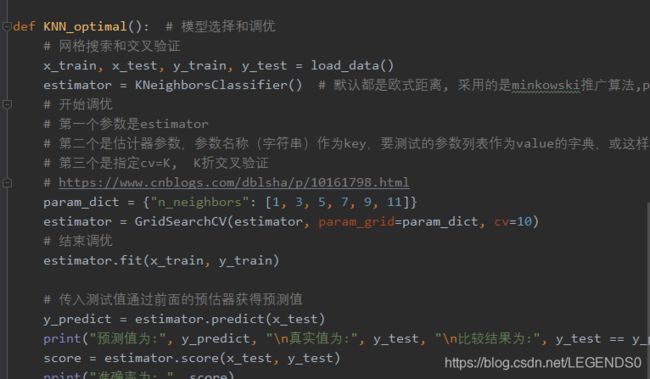Python 机器学习(Machine Learning)入门篇(sklearn), 代码详解
该项目比较适合初学者了解机器学习的原理和一些实践, 代码主要借鉴于黑马程序员, 纯自己手打, 有很多自己的理解
python文件大致如下: 附上百度网盘连接
链接:https://pan.baidu.com/s/1uYkjcL6xa2xmPC9HK_TpDg
提取码:a2th
不需要下载积分, 只希望如果有用的话大家多评论和发表看法, 多点赞, 谢谢大家
下面是部分截图内容和大致文件格式
注:(已经下载好数据集, 不需要自己去找数据了, 方便了不少, 能直接使用)
代码都有注释
下面附上一小部分代码:
线性回归:
# 线性模型包括线性关系和非线性关系两种
# 线性模型包括参数一次幂和自变量一次幂
# 线性关系一定是线性模型, 反之不一定
# 优化方法有两种: 一种是正规方程, 第二种是梯度下降
# 这部分用来训练预测房价
from sklearn.linear_model import LinearRegression, SGDRegressor, Ridge, RidgeCV
from sklearn.datasets import load_boston
from sklearn.model_selection import train_test_split
from sklearn.preprocessing import StandardScaler
from sklearn.metrics import mean_squared_error # 均方误差
"""
Author: Siliang Liu
15/08/2020
Reference itheima.com
"""
def load_data():
boston_data = load_boston()
print("特征数量为:(样本数,特征数)", boston_data.data.shape)
x_train, x_test, y_train, y_test = train_test_split(boston_data.data,
boston_data.target, random_state=22)
return x_train, x_test, y_train, y_test
# 正规方程
def linear_Regression():
"""
正规方程的优化方法
不能解决拟合问题
一次性求解
针对小数据
:return:
"""
x_train, x_test, y_train, y_test = load_data()
transfer = StandardScaler()
x_train = transfer.fit_transform(x_train)
x_test = transfer.transform(x_test)
estimator = LinearRegression()
estimator.fit(x_train, y_train)
print("正规方程_权重系数为: ", estimator.coef_)
print("正规方程_偏置为:", estimator.intercept_)
y_predict = estimator.predict(x_test)
error = mean_squared_error(y_test, y_predict)
print("正规方程_房价预测:", y_predict)
print("正规方程_均分误差:", error)
return None
# 梯度下降
def linear_SGDRegressor():
"""
梯度下降的优化方法
迭代求解
针对大数据
:return:
"""
x_train, x_test, y_train, y_test = load_data()
transfer = StandardScaler()
x_train = transfer.fit_transform(x_train)
x_test = transfer.transform(x_test)
# 建议看下这个函数的api, 这些值都是默认值
# estimator = SGDRegressor(loss="squared_loss", fit_intercept=True, eta0=0.01,
# power_t=0.25)
estimator = SGDRegressor(learning_rate="constant", eta0=0.01, max_iter=10000)
# estimator = SGDRegressor(penalty='l2', loss="squared_loss") # 这样设置就相当于岭回归, 但是建议用Ridge方法
estimator.fit(x_train, y_train)
print("梯度下降_权重系数为: ", estimator.coef_)
print("梯度下降_偏置为:", estimator.intercept_)
y_predict = estimator.predict(x_test)
error = mean_squared_error(y_test, y_predict)
print("梯度下降_房价预测:", y_predict)
print("梯度下降_均分误差:", error)
return None
def linear_Ridge():
"""
Ridge: 岭回归方法
:return:
"""
x_train, x_test, y_train, y_test = load_data()
transfer = StandardScaler() # 建议使用标准化处理数据
x_train = transfer.fit_transform(x_train)
x_test = transfer.transform(x_test)
estimator = Ridge(max_iter=10000, alpha=0.5) # 岭回归
# estimator = RidgeCV(alphas=[0.1, 0.2, 0.3, 0.5]) # 加了交叉验证的岭回归
estimator.fit(x_train, y_train)
print("岭回归_权重系数为: ", estimator.coef_)
print("岭回归_偏置为:", estimator.intercept_)
y_predict = estimator.predict(x_test)
error = mean_squared_error(y_test, y_predict)
print("岭回归_房价预测:", y_predict)
print("岭回归_均分误差:", error)
return None
if __name__ == '__main__':
linear_Regression()
linear_SGDRegressor()
linear_Ridge()逻辑回归:
# 逻辑回归一般是二分类问题
"""
这一部分用逻辑回归来分类breast是否良性
这里需要注意的有一下:
LogisticRegression方法相当于SGDClassifier(loss="log",penalty=" ")
SGDClassifier实现了一个普通的随机梯度下降学习,
也支持平均梯度下降ASGD, 可以设置average=True来开启
"""
from sklearn.linear_model import LogisticRegression, SGDClassifier
from sklearn.model_selection import train_test_split
import pandas as pd
import numpy as np
from sklearn.preprocessing import StandardScaler
from sklearn.metrics import classification_report, roc_auc_score, roc_curve
import matplotlib.pyplot as plt
from sklearn_learning.model_load_store.Util_model import *
"""
Author: Siliang Liu
15/08/2020
Reference itheima.com
"""
def load_data():
"""
先获取数据
处理数据
有缺失值
数据集划分 测试 训练
特征工程
无量纲化-标准化(不要用归一化 之前有笔记)
逻辑回归预估器
模型评估
:return x_train, x_test, y_train, y_test:
"""
column_name = ['Sample code number', 'Clump Thickness',
'Uniformity of Cell Size', 'Uniformity of Cell Shape', 'Marginal Adhesion',
'Single Epithelial Cell Size',
'Bare Nuclei', 'Bland Chromatin',
'Normal Nucleoli', 'Mitoses', 'Class']
# # 网上直接下载
# path = "http://archive.ics.uci.edu/ml/machine-learning-databases/breast-cancer-wisconsin/breast-cancer-wisconsin.data"
# original_data = pd.read_csv(path, names=column_name)
# 文件读取
original_data = pd.read_csv("../../resources/cancer/breast-cancer-wisconsin.data", names=column_name)
# 缺失值处理
# 第一步先替换 ? 为 nan
data = original_data.replace(to_replace="?", value=np.nan)
# 第二步可以选择前面笔记里面自己写的的过滤nan也可以用简单的方法如下:
data.dropna(inplace=True)
print("检测是否还有缺失值(全为false表示没有缺失值)\n", data.isnull().any()) # 检测是否还有缺失值
# 第三步 筛选特征值和目标值
x = data.iloc[:, 1:-1] # 表示每一行数据都要, 从第一列到倒数第二列的column字段也要
y = data["Class"]
x_train, x_test, y_train, y_test = train_test_split(x, y)
return x_train, x_test, y_train, y_test
def logic_Regression():
"""
逻辑回归的真实值是分类, 也就是是否属于某一个类别,和线性回归不一样
线性回归损失函数: (y_predict-y_true)平方和/总数
逻辑回归损失函数: 对数似然损失(https://blog.csdn.net/u014182497/article/details/82252456)
逻辑回归用sigmoid函数为例子: 需要把结果映射到sigmoid函数上
分两种情况:(见截图) y轴表示损失值, 横轴x表示映射结果.(分段函数)
当真实值为1 见 对数似然损失-1.png
当真实值为0 见 对数似然损失-2.png
不难理解,需要对着图看
逻辑回归损失值得到后需要用梯度下降来优化
后续就差不多
:return:
"""
x_train, x_test, y_train, y_test = load_data()
# 第四步: 开始特征工程
transfer = StandardScaler()
x_train = transfer.fit_transform(x_train)
x_test = transfer.transform(x_test)
# 第五步, 预估器流程
estimator = LogisticRegression() # 默认参数
estimator.fit(x_train, y_train)
print("逻辑回归_权重系数为: ", estimator.coef_)
print("逻辑回归_偏置为:", estimator.intercept_)
# store_model(estimator, "logic_regression_model01.pkl") # 保存模型
# estimator = load_model("logic_regression_model01.pkl") # 加载模型
# 第六步, 模型评估
y_predict = estimator.predict(x_test)
print("逻辑回归_预测结果", y_predict)
print("逻辑回归_预测结果对比:", y_test == y_predict)
score = estimator.score(x_test, y_test)
print("准确率为:", score)
# 2是良性的 4是恶性的
"""
但是实际上这个预测结果不是我们想要的, 以上只能说明预测的正确与否,
而事实上, 我们需要一种评估方式来显示我们对恶性breast的预测成功率, 也就是召回率
同时可以查看F1-score的稳健性
(召回率和精确率看笔记和截图)
所以下面换一种评估方法
"""
Score = classification_report(y_test, y_predict, labels=[2, 4],
target_names=["良性", "恶性"])
print("查看精确率,召回率,F1-score\n", Score)
# support表示样本量
"""
ROC曲线和AUC指标(样本分类不均衡的情况下,可以使用这种方法)
AUC = 0.5 是瞎猜模型
AUC = 1 是最好的模型
AUC < 0.5 属于反向毒奶
更多的看截图
"""
# 需要转换为0,1表示
y_true = np.where(y_test > 3, 1, 0) # 表示大于3为1,反之为0(class值为2和4)
return_value = roc_auc_score(y_true, y_predict)
print("ROC曲线和AUC返回值为(三角形面积)", return_value)
fpr, tpr, thresholds = roc_curve(y_true, y_predict)
plt.plot(fpr, tpr)
plt.show()
return None
if __name__ == '__main__':
logic_Regression()
希望对大家都有帮助!!!

